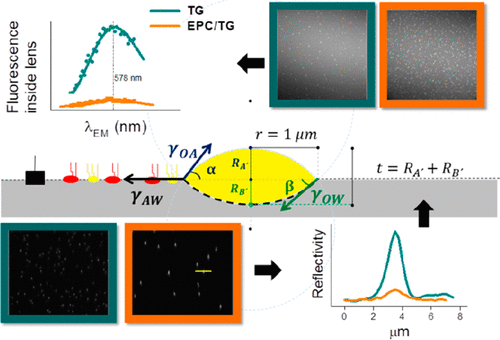Our official English website, www.x-mol.net, welcomes your
feedback! (Note: you will need to create a separate account there.)
Triglyceride Lenses at the Air–Water Interface as a Model System for Studying the Initial Stage in the Biogenesis of Lipid Droplets
Langmuir ( IF 3.7 ) Pub Date : 2021-09-07 , DOI: 10.1021/acs.langmuir.1c01359 B Caruso 1, 2 , N Wilke 3, 4 , M A Perillo 1, 2
Langmuir ( IF 3.7 ) Pub Date : 2021-09-07 , DOI: 10.1021/acs.langmuir.1c01359 B Caruso 1, 2 , N Wilke 3, 4 , M A Perillo 1, 2
Affiliation

|
Lipid droplets (LD) are intracellular structures consisting of an apolar lipid core, composed mainly of triglycerides (TG) and steryl esters, coated by a lipid–protein mixed monolayer. The mechanisms underlying LD biogenesis at the endoplasmic reticulum membrane are a matter of many current investigations. Although models explaining the budding-off of protuberances of phase-segregated TG inside bilayers have been proposed recently, the assumption of such initial blisters needs further empirical support. Here, we study mixtures of egg phosphatidylcholine (EPC) and TG at the air–water interface in order to describe some physical properties and topographic stability of TG bulk structures in contact with interfaces. Brewster angle microscopy images revealed the appearance of microscopic collapsed structures (CS) with highly reproducible lateral size (∼1 μm lateral radius) not varying with lateral packing changes and being highly stable at surface pressures (π) beyond collapse. By surface spectral fluorescence microscopy, we were able to characterize the solvatochromism of Nile Red both in monolayers and inside CS. This allowed to conclude that CS corresponded to a phase of liquid TG and to characterize them as lenses forming a three-phase (oil–water–air) system. Thereby, the thicknesses of the lenses could be determined, observing that they were dramatically flattened when EPC was present (6–12 nm compared to 30–50 nm for lenses on EPC/TG and TG films, respectively). Considering the shape of lenses, the interfacial tensions, and the Neumann’s triangle, this experimental approach allows one to estimate the oil–water interfacial tension acting at each individual microscopic lens and at varying compression states of the surrounding monolayer. Thus, lenses formed on air–water Langmuir films can serve to assess variables of relevance to the initial step of LD biogenesis, such as the degree of dispersion of excluded-TG phase and shape, spatial distribution, and oil–water interfacial tension of lenses.
中文翻译:

空气-水界面的甘油三酯透镜作为研究脂滴生物发生初始阶段的模型系统
脂滴 (LD) 是由非极性脂质核心组成的细胞内结构,主要由甘油三酯 (TG) 和甾醇酯组成,被脂质-蛋白质混合单层包裹。内质网膜上 LD 生物发生的潜在机制是许多当前研究的问题。尽管最近提出了解释双层内相分离 TG 突起萌芽的模型,但这种初始起泡的假设需要进一步的经验支持。在这里,我们研究了鸡蛋磷脂酰胆碱 (EPC) 和 TG 在空气-水界面的混合物,以描述与界面接触的 TG 本体结构的一些物理特性和形貌稳定性。布鲁斯特角显微镜图像显示微观塌陷结构 (CS) 的外观具有高度可重复的横向尺寸(~1 μm 横向半径),不随横向堆积变化而变化,并且在超过塌陷的表面压力 (π) 下高度稳定。通过表面光谱荧光显微镜,我们能够表征尼罗红在单层和 CS 内部的溶剂化变色。这使得可以得出结论,CS 对应于液体 TG 的相,并将它们表征为形成三相(油-水-空气)系统的透镜。因此,可以确定透镜的厚度,观察到当 EPC 存在时它们显着变平(6-12 nm,而 EPC/TG 和 TG 膜上的透镜分别为 30-50 nm)。考虑到透镜的形状、界面张力和诺依曼三角形,这种实验方法允许人们估计作用在每个单独的微观透镜和周围单层的不同压缩状态下的油水界面张力。因此,在空气-水朗缪尔薄膜上形成的透镜可用于评估与 LD 生物发生的初始步骤相关的变量,例如排除的 TG 相和形状的分散程度、空间分布和透镜的油水界面张力.
更新日期:2021-09-21
中文翻译:

空气-水界面的甘油三酯透镜作为研究脂滴生物发生初始阶段的模型系统
脂滴 (LD) 是由非极性脂质核心组成的细胞内结构,主要由甘油三酯 (TG) 和甾醇酯组成,被脂质-蛋白质混合单层包裹。内质网膜上 LD 生物发生的潜在机制是许多当前研究的问题。尽管最近提出了解释双层内相分离 TG 突起萌芽的模型,但这种初始起泡的假设需要进一步的经验支持。在这里,我们研究了鸡蛋磷脂酰胆碱 (EPC) 和 TG 在空气-水界面的混合物,以描述与界面接触的 TG 本体结构的一些物理特性和形貌稳定性。布鲁斯特角显微镜图像显示微观塌陷结构 (CS) 的外观具有高度可重复的横向尺寸(~1 μm 横向半径),不随横向堆积变化而变化,并且在超过塌陷的表面压力 (π) 下高度稳定。通过表面光谱荧光显微镜,我们能够表征尼罗红在单层和 CS 内部的溶剂化变色。这使得可以得出结论,CS 对应于液体 TG 的相,并将它们表征为形成三相(油-水-空气)系统的透镜。因此,可以确定透镜的厚度,观察到当 EPC 存在时它们显着变平(6-12 nm,而 EPC/TG 和 TG 膜上的透镜分别为 30-50 nm)。考虑到透镜的形状、界面张力和诺依曼三角形,这种实验方法允许人们估计作用在每个单独的微观透镜和周围单层的不同压缩状态下的油水界面张力。因此,在空气-水朗缪尔薄膜上形成的透镜可用于评估与 LD 生物发生的初始步骤相关的变量,例如排除的 TG 相和形状的分散程度、空间分布和透镜的油水界面张力.











































 京公网安备 11010802027423号
京公网安备 11010802027423号